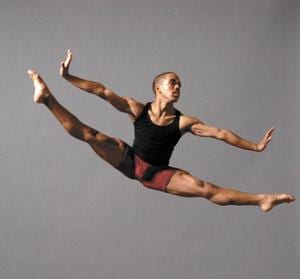The common narrative of a gay youth inspired to take up classical dance usually involves alabaster-skinned swans, broad-shouldered princes or perhaps a human-sized implement for cracking nuts. But in the case of Daniel Harder, company member with Alvin Ailey American Dance Theater, it all started with Janet Jackson.
Growing up in a suburb of Washington, DC, Harder had a long-time dream of becoming a hip-hop pro. But after he caught the local stop of Ms Rhythm Nation’s 1998 Velvet Rope tour, he realized what it was he really needed to do.
“I had already decided in my mind I would dance for Janet someday, and seeing that show made me more sure of it than ever,” he laughs. “But when I did more research after the show I found out her dancers usually studied ballet. I realized if I ever wanted to dance for her I would have to do the same.”
Intent on building his technique, Harder took drop-in classes at a local studio. He got a break early on when a friend of his mother’s got a tip that Debbie Allen (of Fame fame) would be auditioning dancers for her academy at the Kennedy Centre. Though he didn’t make it through the first round, Allen approached him after the audition and invited him to attend her summer program in Los Angeles. Featuring a mix of artists and teachers from across the globe, it opened his eyes to the possibility of a full-fledged dance career.
Returning home, Harder enrolled in a performing arts high school and was later awarded a scholarship with The Ailey School in New York; he joined the company shortly after. Its current show, which restages a number of founder Alvin Ailey’s original choreographies alongside those of newly appointed artistic director Robert Battle and a few guests, kicks off a four-month tour in Toronto.
Of the four pieces he performs (there are eight in total over two evenings), Harder’s biggest challenge will be the lead role in Home, guest choreographer Rennie Harris’s hip-hop infused exploration of the lives of people living with HIV. Created in partnership with drug company Bristol-Myers Squibb, the work began with a call for people living with the virus to submit their stories, which were then used as a creative starting point. While the work is abstract and doesn’t present a specific narrative, creating it allowed company members to connect with the realities of HIV today.
“When I looked at each individual’s journey, I was impressed by how they chose to approach the disease, not looking at it as a burden and continuing to push forward in their lives without letting it hold them back,” he says. “At the same time I saw the amount of stigma around it and realized the ways that we as a community have failed. HIV is just one facet of an individual’s life, and our community needs to work harder to reach out to each other.”
Commitment to a broader community is a key element of Harder’s level-headedness. Though egos can swell with early success (he’s only 24), he remains passionately dedicated to ensuring future generations of artists will have opportunities like he had.
“I’ve been given so much at a very young age, so it’s extremely important to me that I can give something back,” he says. “Eventually I’d like to start my own company and help give young dancers an opportunity to develop. And, of course, if Janet calls I’ll have to go dance for her.”


 Why you can trust Xtra
Why you can trust Xtra


